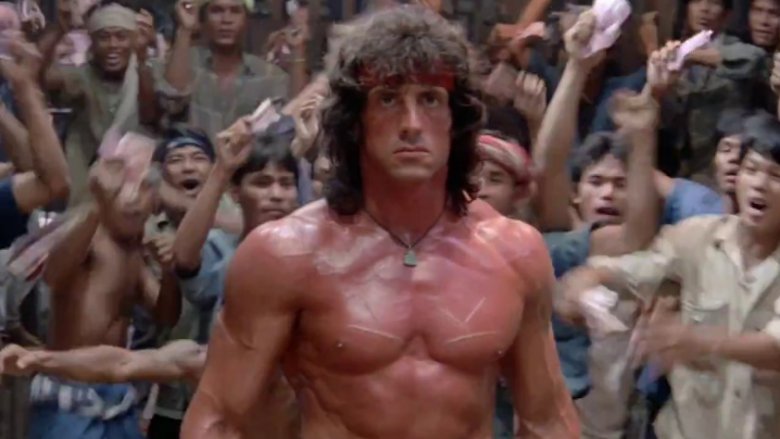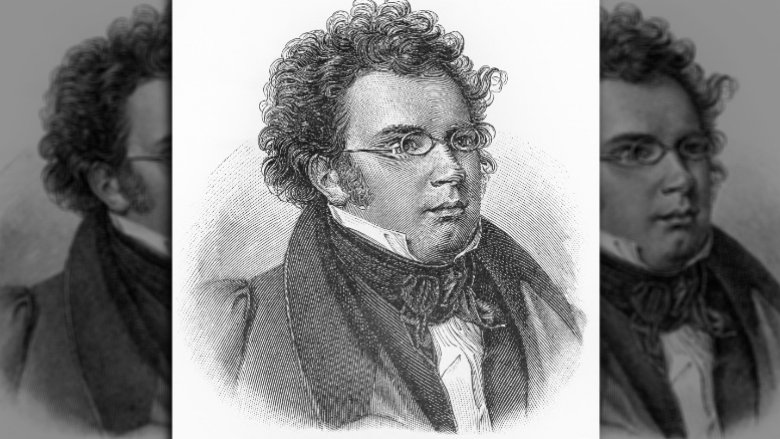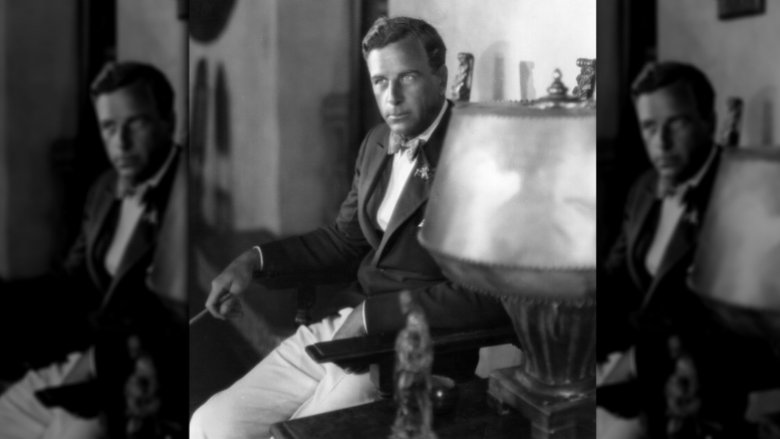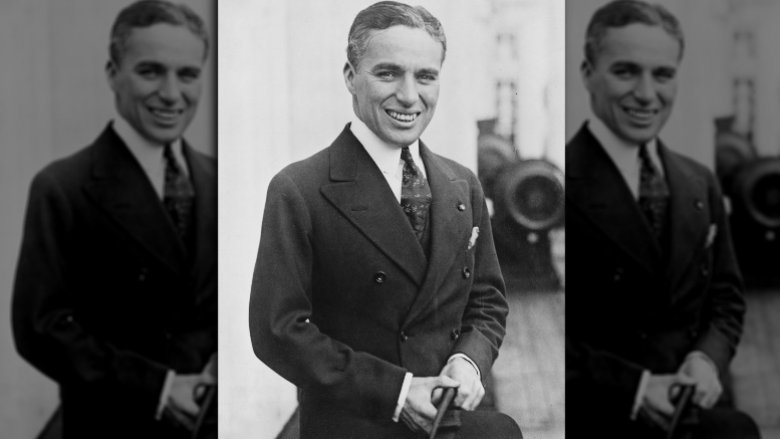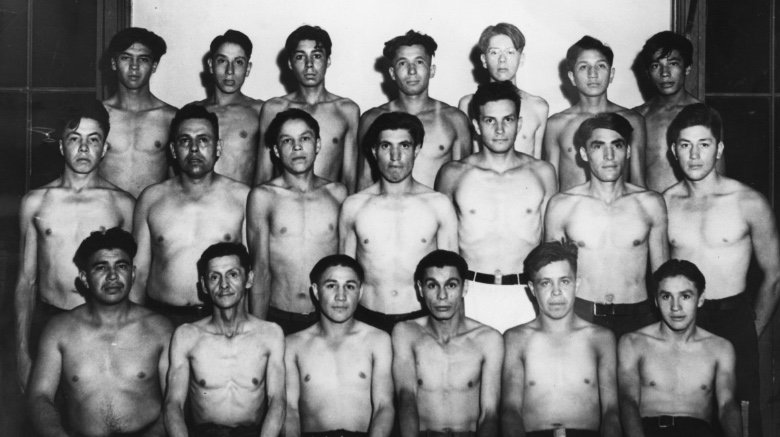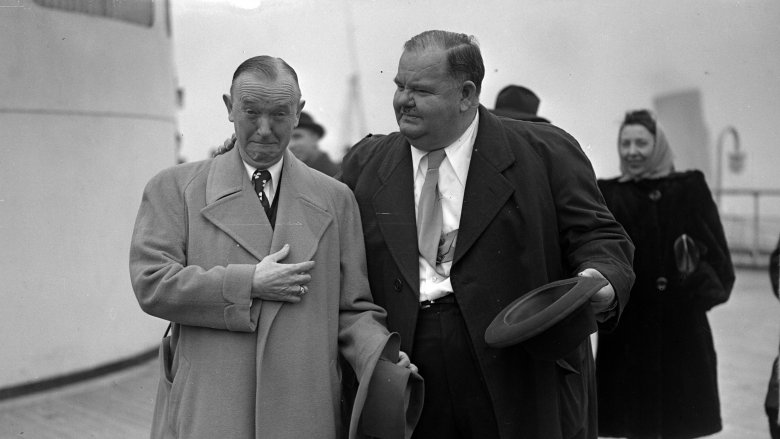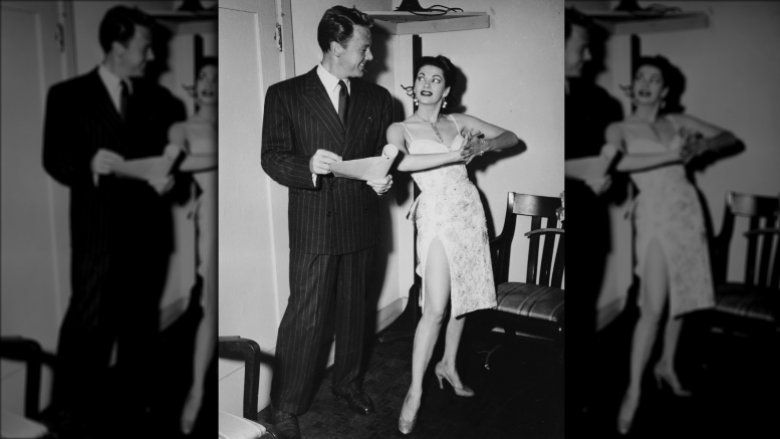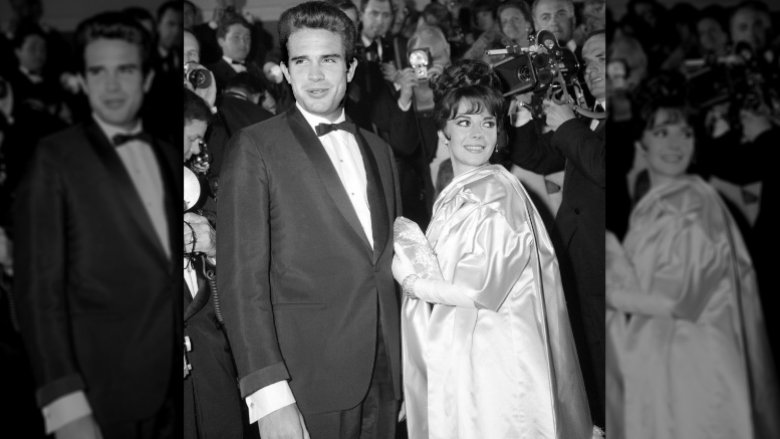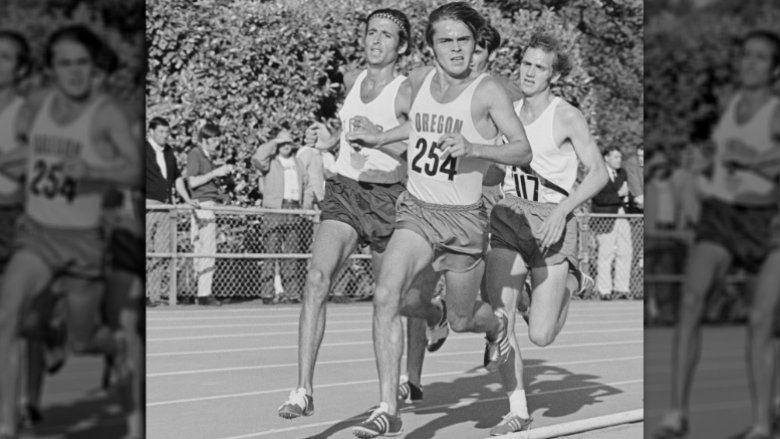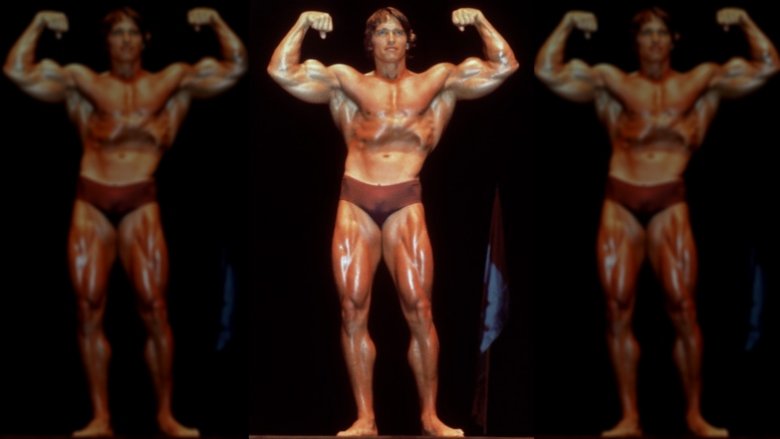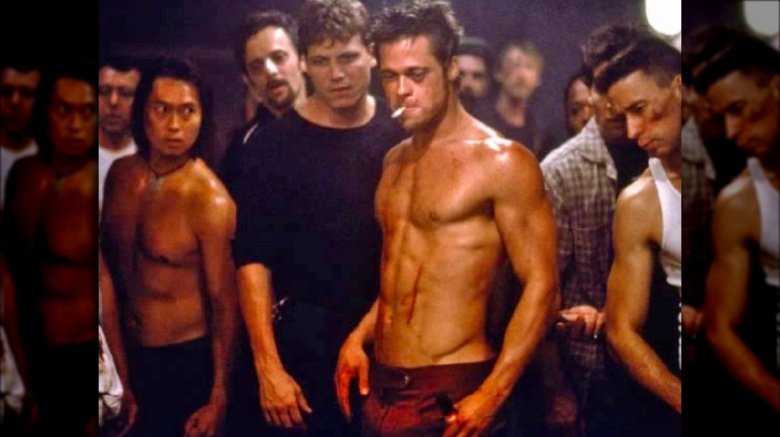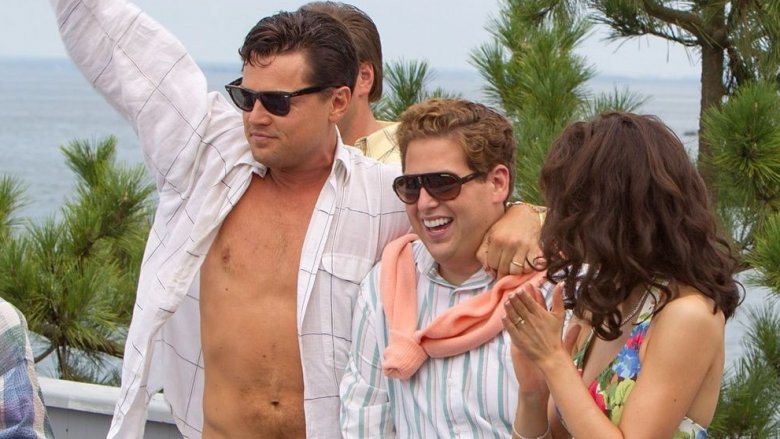How Men's Body Types Have Changed Throughout The Decades
A lot has changed in the last century. If you were to travel back in time to 1918, you'd see Model Ts roaming the streets, people buying their houses via catalog, and movie theaters playing silent films starring Charlie Chaplin. You'd also probably notice just how different people looked — and not even just because of how they styled their hair or the types of clothes they wore — but also physically.
Imagining what the world would be like in the year 2000, Jean-Marc Côté and other artists from the turn of the 19th century crafted paper cards. While they thought men would be able to ride — wait for it — seahorses and fish in the future, men and women were still depicted with their late 1800s and early 1900s body types and clothing. Côté and his contemporaries failed to predict how vastly different people would look by the new millennium. Let's take a peek at how men's body types have evolved through the decades, shall we?
The 1900s: we're fat and we're making the most of it!
In 1903, set in the town of Wells River, Vermont, a club with the mantra "We're fat and we're making the most of it!" began accepting members. According to NPR, the club only accepted men who weighed a minimum of 200 pounds. There was also a $1 entrance fee, a secret handshake, and password.
"This village is full of bulbous and overhanging abdomens and double chins tonight, for the New England Fat Men's Club is in session at Hale's Tavern," read a 1904 Boston Globe article (via NPR), "The natives, who are mostly bony and angular, have stared with envy at the portly forms and rubicund faces which have arrived on every train."
Despite being a coveted body type of the time, there was a fine line between being "chubby chic" as these men were and being morbidly obese, which was definitively not celebrated, according to Peter Stearns, a professor of history at George Mason University and author of Fat History.
The 1910s: slimming down
Despite their popularity in the early 1900s, fat men's clubs would not last forever. "In general, in a trend that began around 1910, doctors and insurance actuaries began to push preferability of underweight to overweight, in terms of health and longevity," wrote Peter Stearns in Fat History: Bodies and Beauty in the Modern West.
Ironically, though, it wasn't actually the medical industry who initiated this idea. Patients were the ones putting pressure on the doctors. "Not only were middle-class people being told to worry about their weight by 1910," Stearns explained, "they were worrying." They were concerned that their weight would send a "symbolic message of laziness and moral failure."
During the 1910s and '20s, Stearns said the "American anxiety about fat had engendered a powerful culture." This diet culture was just beginning to take root some 100 years ago — and it is still something that permeates our day.
The 1920s: slim is officially in
By the time the New England Fat Men's Club in Vermont held its last meeting in 1924, only 38 members were present — none of whom met the once required 200 pounds, NPR reported. Nationwide, people had slimmed down.
The timing really could not have been worse for a new major industry to find its footing. Just as people were already feeling uneasy about their weight, "motion-picture companies began to migrate from the East Coast to California, where weather conditions offered the opportunity for nearly year-round shooting," Lynne Luciano wrote in Looking Good: Male Body Image in Modern America. Yes, Hollywood had arrived. As a result, Americans became even more "image-conscious" than before.
By the beginning of the 1920s, Hollywood was already synonymous with thin, attractive movie stars. "For bodies to look beautiful on film," Luciano explained, "actors and actresses had to be slim, because cameras automatically added twenty pounds to actual weight." Outside of Hollywood, men began to follow the trend.
The 1930s: getting fit
If you were to ask any man in your life to name the "manliest" man in history, there's a good chance Theodore Roosevelt's name would be mentioned — which is a pretty big deal for a guy who went by "Teddy" and is responsible for the stuffed bear of the same name. Nevertheless, Josep M. Armengol, a renowned masculinity scholar, said it was actually the other famous Roosevelt — Franklin Delano — who, along with his administration, attempted to "remasculanize" America.
According to the scholar's article, "Gendering the Great Depression: rethinking the male body in 1930s American culture and literature," the Great Depression left millions of American men feeling "emasculated by their incapacity to provide for their families." Armengol contends that the Roosevelt administration promoted "numerous images of 'hard' bodies at work" in a "remasculinizing effort." Through paintings and literature, men in this decade were influenced not to look like the skinny 1920s movie stars, but a man's man of the 1930s.
The 1940s: multiple types of men
In the early 1940s, an American psychologist and physician by the name of William Sheldon classified people as having one of three distinct body types. According to his research, some people were "endomorphs": round and soft individuals. Others were "mesomorphs": people who were square and muscular. And others still were "ectomorphs": thin and fine-boned.
But Sheldon didn't just stop at classifying body types. No, he also assigned personality traits to the different types. Endmorphs tended to have "viscerotonic" personalities, meaning they were extroverted and comfortable. Mesomorphs were often "somotonic" — or assertive and aggressive. Ectomorphs tended to be introverts who were thoughtful and sensitive, or what Sheldon dubbed "cerebrotonic."
According to his classifications, muscular people with their "aggressive" personalities were likely to participate in criminal behavior. Hmm. Didn't anyone ever tell him not to judge a book by its cover? Yet and still, Sheldon's research was considered groundbreaking at the time.
The 1950s: tall and distinguished
In 1953, Hugh Hefner's first issue of Playboy — featuring then-unknown Marilyn Monroe — hit newsstands. Before Playboy, though, there was Esquire. According to Lynne Luciano's book Looking Good, Esquire was able to achieve success despite costing a staggering five times more than that of other magazines — and in the height of the Great Depression. In the '50s, Esquire continued on alongside Hefner's magazine. Luciano differentiated the expensive magazine from the others, writing, "The Esquire man wasn't a playboy; he was 'tall, distinguished, middle-aged... [and] well-positioned."
According to the mid-century book The Pyramid Climbers, Esquire wasn't the only company who recognized tall men as the superior body type of the time. The Diamond Alkali Company, an American chemical company, is cited as asking sales personnel on their screening forms: "Is he physically large and impressive?" Financial executive Ward Howell is also quoted in the book as saying "the head of a large electronics company, asking for a controller, said: 'I want a very tall man for this job, a very impressive guy.'"
The 1960s: big men
Following the tall men trend of the 1950s, the 1960s also focused on men of great stature. But in addition to being tall, being big was also now the preferred body type in the United States.
John Handy, who is described as "a medium-tall man" in Vance Packard's The Pyramid Climbers, spent many years in the '50s and '60s recruiting sales executives. "The fashion now is for big men," he is quoted as saying in the 1962 publication, "In the old days in some of the companies the tallest executive was five feet five, but now the fashion is for big men even though there are plenty of small men doing a terrific job." At times, companies would actually require him to only submit candidates who were a minimum of six feet tall. Handy himself concluded that "the big man is preferred because 'he has a certain presence.'"
The 1970s: sexy, fit, and lean
Despite the ideal body type being big and tall in the 1960s, Lynne Luciano wrote in Looking Good that "beautiful bodies" hadn't been all that important. That changed in the 1970s: "...instead of being expressed through political activism and protest, youthfulness would be projected by the body — a body that was as sexy, fit, and lean as an eighteen-year-old's."
By the end of the '70s, nearly half of Americans said they exercised on a regular basis — and running was their sport of choice. In 1969, only 30-some marathons were held across the United States. By the mid-'70s, however, there were about 200. Some of the fervor for the sport was spurred by Frank Shorter, the man considered by some to be "the father of the modern running boom." Shorter won the Olympics in 1972, becoming the first American to win in over six decades, which certainly motivated many people to run and, likewise, attain a similar body type to his.
The 1980s: the hard body
Although Franklin D. Roosevelt and his administration may have tried hard to push "hard" bodies on the American people, the real era of muscular men was in the 1980s.
Susan Jeffords highlights how this body type took shape in her book, Hard Bodies: Hollywood Masculinity in the Reagan Era. During Ronald Reagan's presidency, three Rambo films premiered in movie theaters across the country. With each subsequent film, the muscles of Sylvester Stallone's character only grew. Other movies also worked to enforce the "hard body" appeal. An Officer and a Gentleman, for example, is described in Hard Bodies as having a plot that is essentially about "a no-good, flip, useless, and soft male body" that is transformed into a strong, muscular one.
Outside of Hollywood, Mr. Universe (later, Mr. Olympia) competitions also reigned supreme in Reagan's era. Even Ronald Reagan himself demonstrated what political author John Orman dubbed the "macho presidential style."
The 1990s and 2000s: the average (muscular) Joe
It won't take you long to remember what the ideal body type was in the '90s once you start thinking about your old Hollywood heartthrobs. What did Freddie Prinze Jr., Luke Perry, and Jared Leto all have in common? They were thin, yes, but all decidedly average. By the late '90s, men with small-framed builds also started packing on muscle — but not Reagan era muscle. Instead, it was all about looking lean. Men have Brad Pitt's character, Tyler Durden, in Fight Club to thank for this change in body type.
Even as we transitioned into the 21st century, men were still desiring this body type. Personal trainer Tim Walker told Esquire (via Nikos Marinos Consultancy) in 2015 that "Brad Pitt in Fight Club" was still "the body blokes ask for." Walker added that this body type can be achieved through "physique training" and is more sustainable than the body-building popularized in the '80s.
The 2010s and beyond: the dad bod
Unfortunately for men who spent the bulk of the early 2000s getting jacked, the "dad bod" became an ideal body type for men in the 2010s. In 2016, Richard G. Bribiescas, Professor of Anthropology, Ecology and Evolutionary Biology at Yale, told Maxim that women are more attracted to men with a "dad bod," which is a body type marked by "lower testosterone levels, less muscle mass and more fat." According to the professor's research, men who carry a few extra pounds were also found to be less likely to have a heart attack or suffer from prostate cancer.
A survey of about 2,000 people conducted by Planet Fitness (via Shape) echoed Bribiescas' findings. A whopping 69 percent of women said they found dad bods attractive and 47 percent even considered the dad bod to be "the new six-pack." Hmm, maybe riding seahorses isn't all that far-fetched after all.
